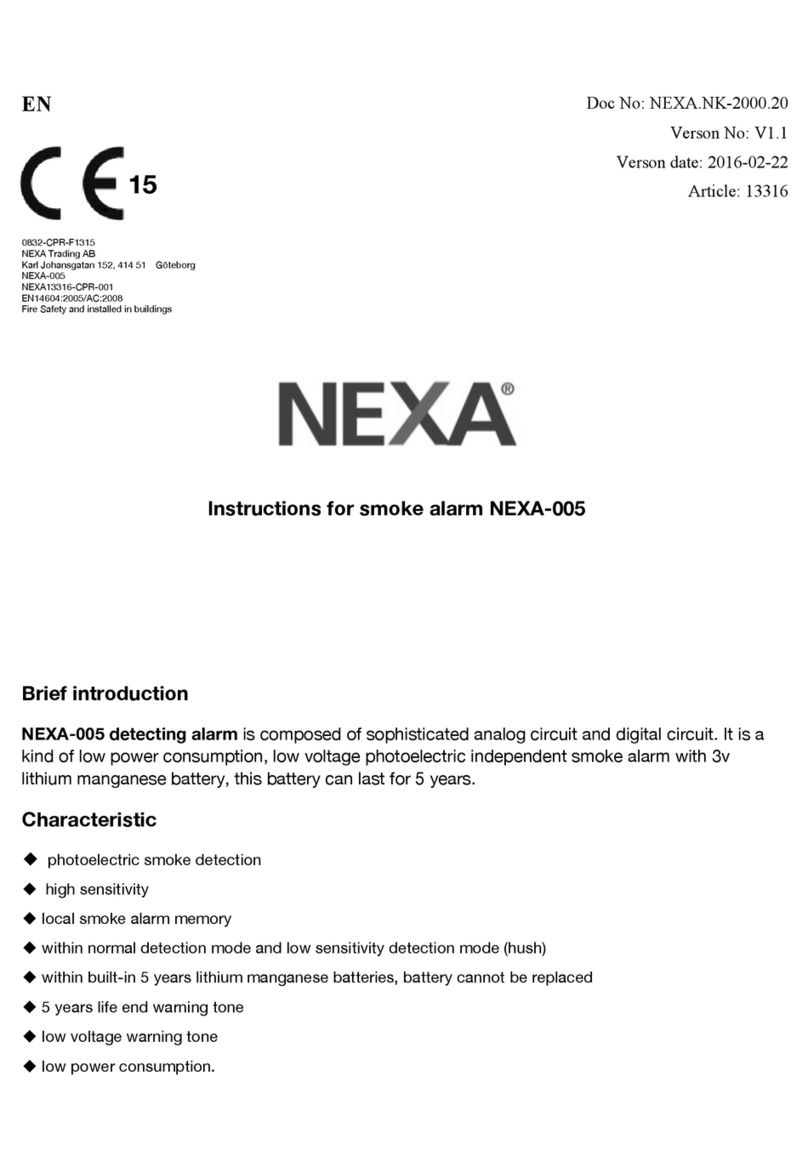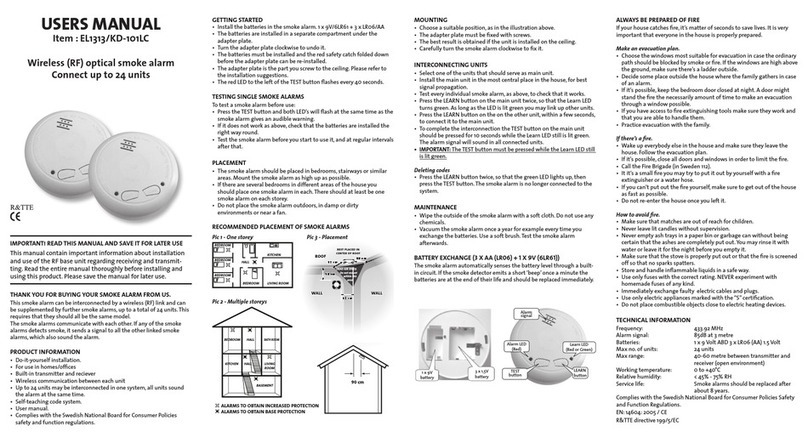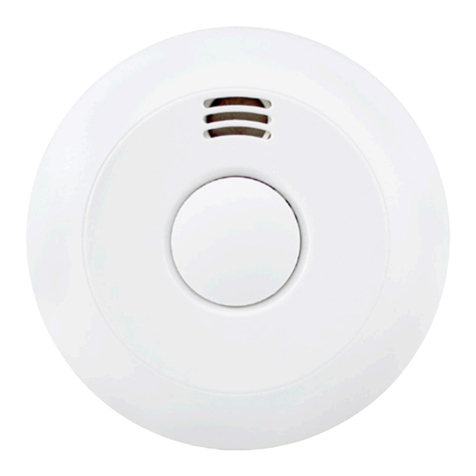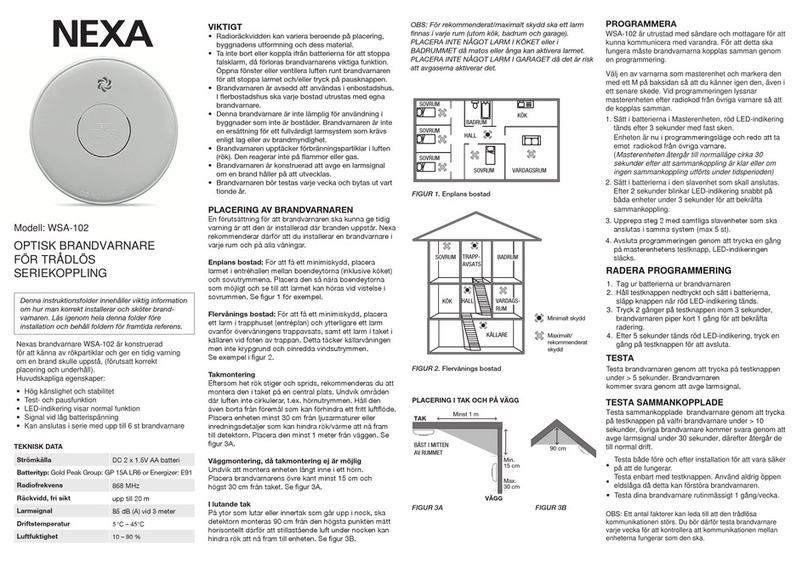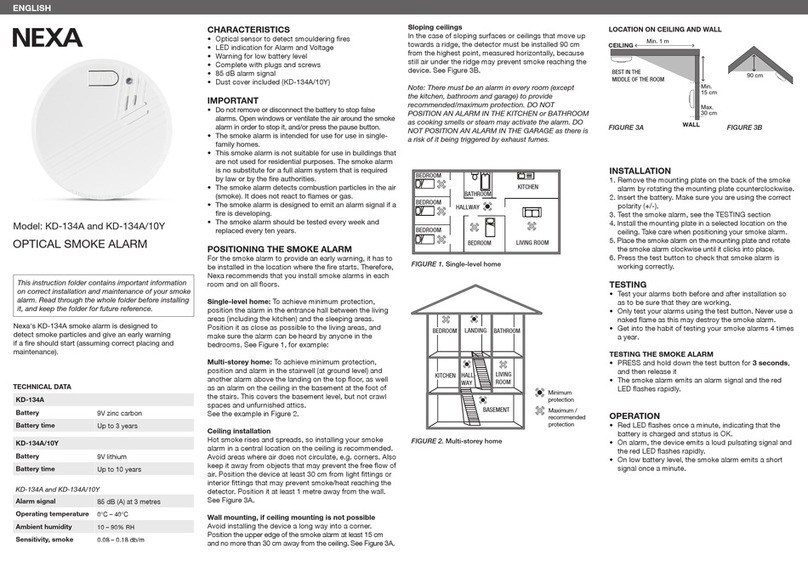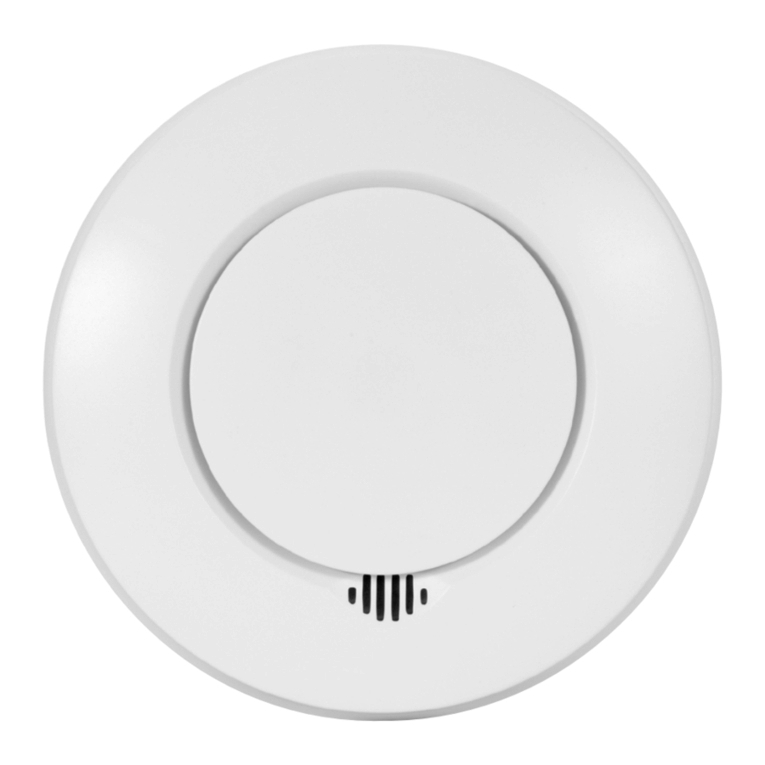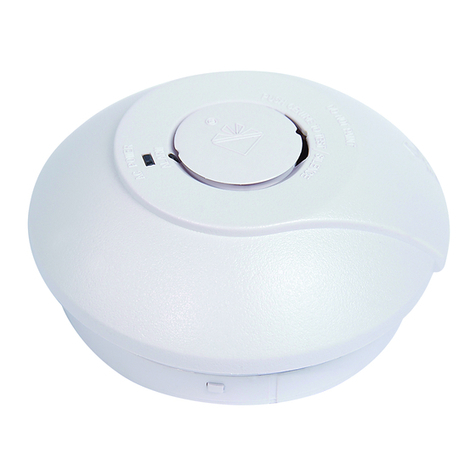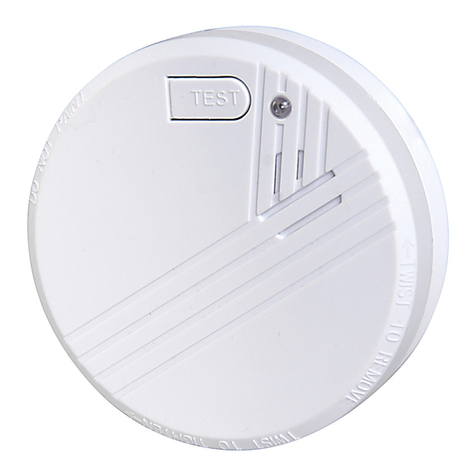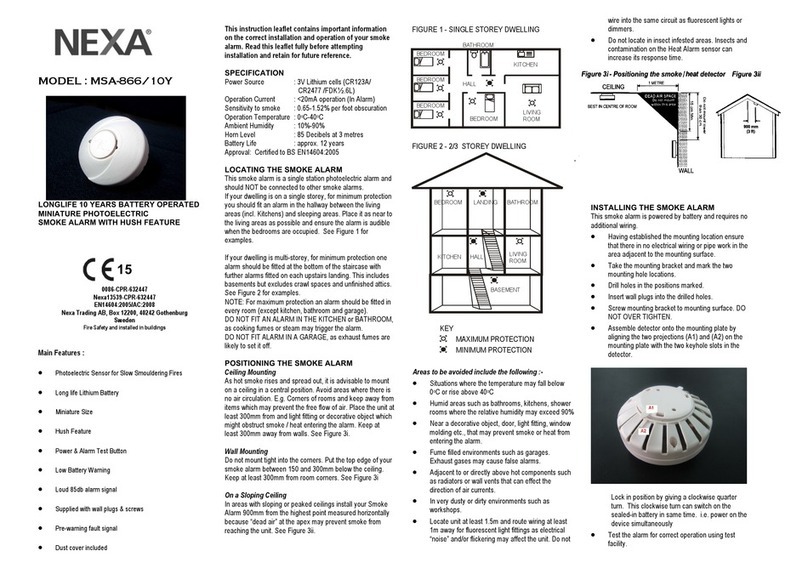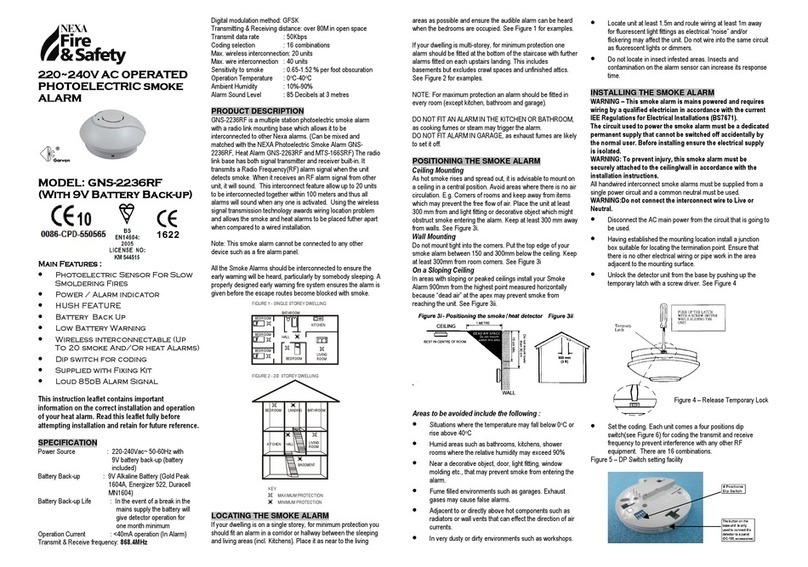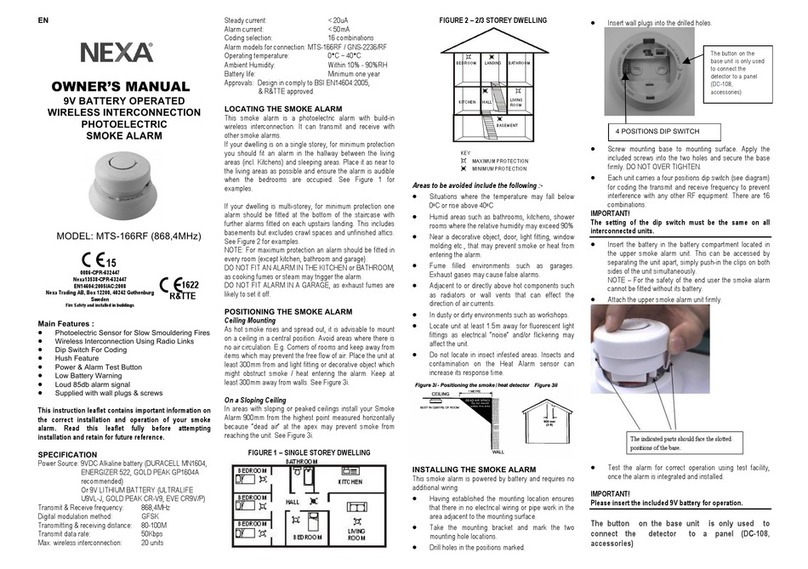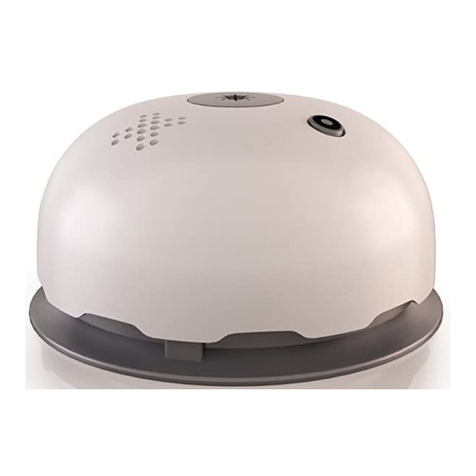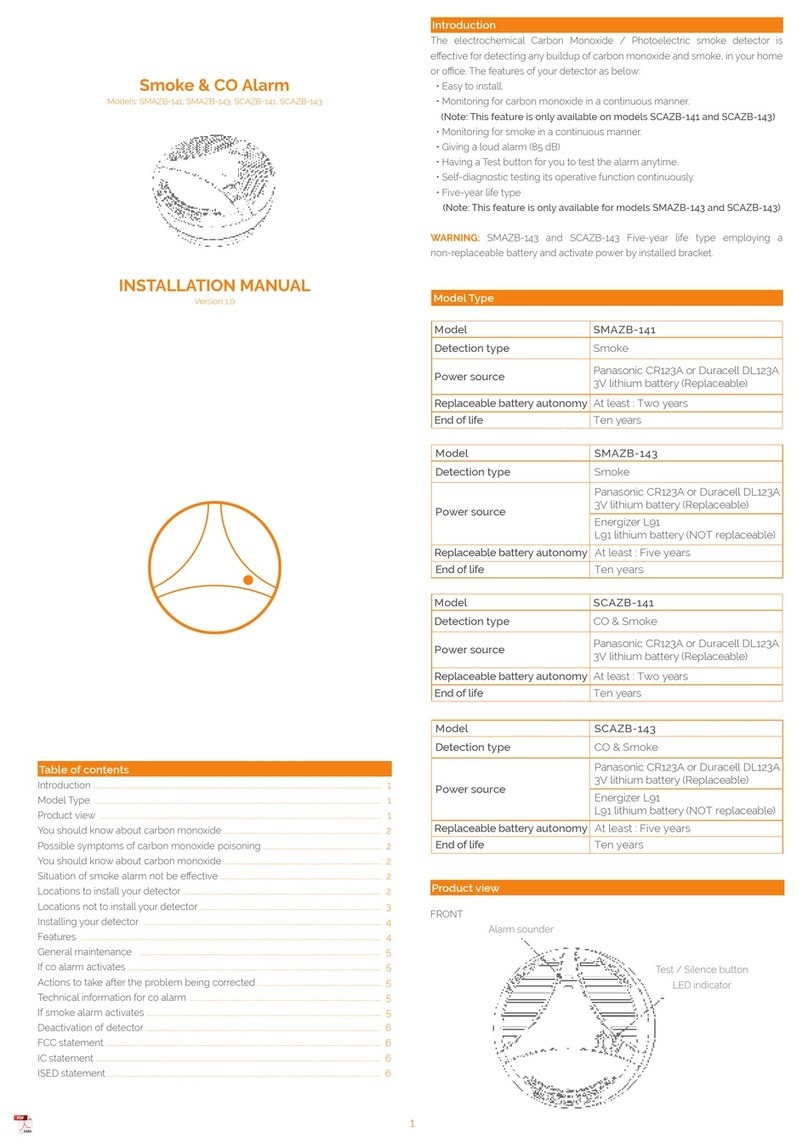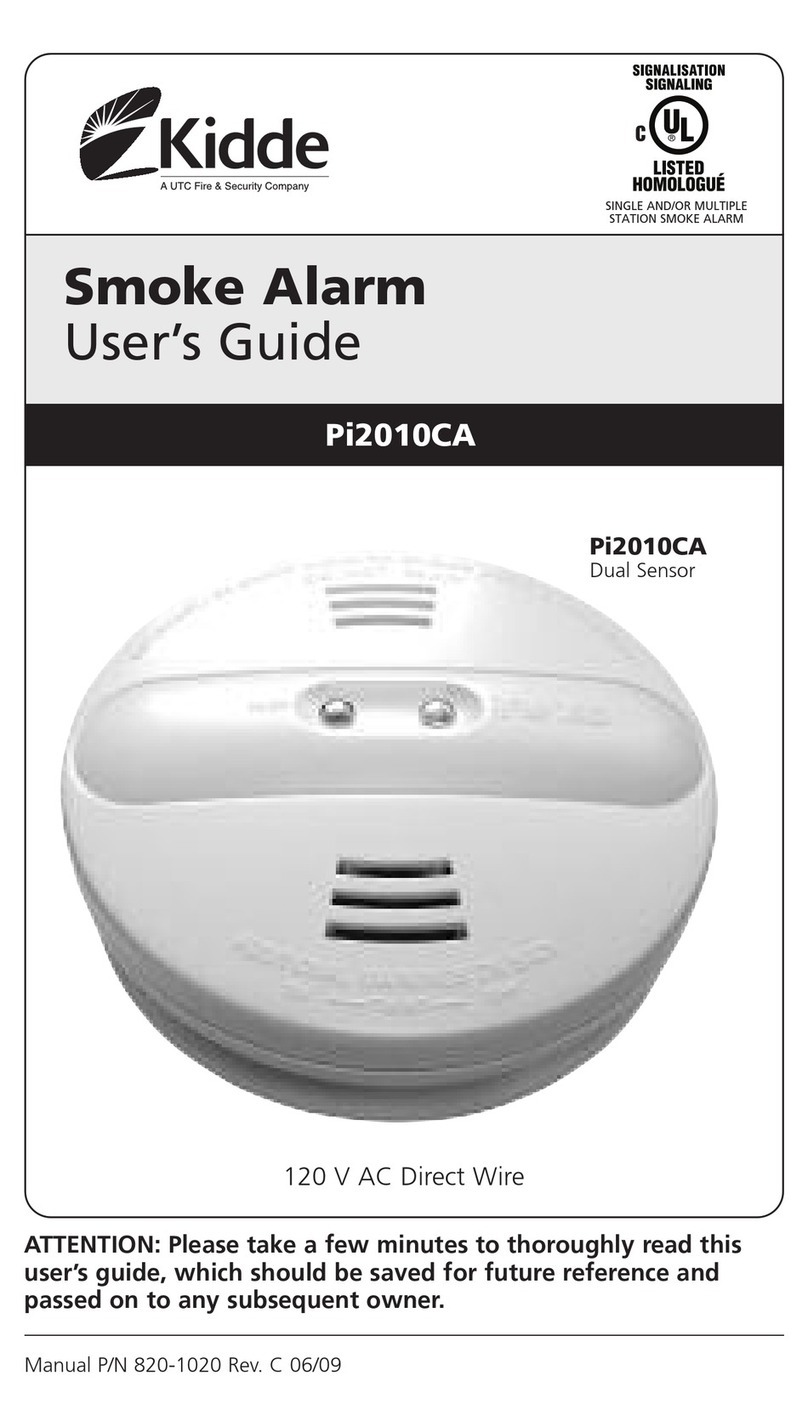
DELETING PROGRAMMING (resetting)
1. Press and hold the test button on the device to be
reset for about 20 seconds until the LED indicator
starts ashing quickly, then release the button. The
LED indicator is now lit solidly.
2. When the LED indicator is lit solidly, press the test
button twice. Upon successful reset, the re alarm
sounds with a short beep.
3. Repeat steps 1 and 2 with all devices to be reset.
NOTE: everal factors may cause wireless communication
to interfere. Therefore, you should test fire detectors
every week to check that the communication between
the devices is working properly.
OPERATION
When operating normally, the smoke alarm’s LED
ashes every 40 seconds. This means that the battery
and device are working correctly. If the alarm detects
smoke, it will emit a loud, pulsing alarm and the red LED
will ash until the smoke has gone.
PAUSE FUNCTION
The smoke alarm has a combined button for the test
and pause functions. You can use the pause function to
stop the alarm signal if the alarm is triggered due to a
false alarm. The pause function is activated by holding
down the test/pause button while the device is emitting
an alarm. The alarm will be stopped for 10 minutes.
The smoke alarm is reset to normal sensitivity after the
end of the 10-minute pause period. If necessary, press
the pause button again to pause the alarm again. If you
have smoke alarms connected in series, you can pause
all interlinked devices by pressing the test and pause
button on the device that triggered the alarm.
REPLACING THE BATTERIES
How often the batteries need to be replaced is dependent
on the battery type. Where possible, get into the habit of
replacing the batteries once a year, ideally on a specic date.
1. Rotate the smoke alarm counterclockwise to remove
it from the mounting plate.
2. Remove the old batteries.
3. Insert new batteries. Check that the polarity is
correct, +/-.
4. Place the smoke alarm on the mounting plate and
rotate the smoke alarm clockwise until it clicks into
place.
5. Press the test button to test the smoke alarm.
ALARM SIGNALS
The FS-558/RF emits various alarm signals. The alarm that
detected smoke or heat emits a different audible signal so
that you can identify which alarm triggered the alert.
COMMON CAUSES AND HOW TO AVOID
FALSE ALARMS
Smoke alarms detect and react to smoke particles in the
air. These smoke particles are what cause the smoke
alarm to sound. This function means that the smoke alarm
may also react to dust particles, moisture or other particles
in the form of pollen, insects, etc. These factors frequently
cause false alarms.
Manufacturer:
Nexa Trading AB, Sweden
The Declaration of Performance (DoP) can
be found on our website – www.nexa.se
STATUS RED LED ALARM SIGNAL
Normal mode Flashes once
every 40 seconds None
Replace batteries/
low battery voltage
Flashes once
every 40 seconds
Short audible signal
every 40 seconds
Fault notification None Short audible signal
every 40 seconds
Pause mode Flashes once
every 8 seconds None
STATUS RED LED ALARM SIGNAL
The smoke alarm
detects smoke Flashes
Repeating:
3 long audible signals –
pause
The smoke
alarm detects a
temperature increase
Flashes
Repeating:
3 short audible signals –
pause
Devices connected
wirelessly and
receiving signal
from triggered alarm
Flashes
Repeating:
2 short audible signals –
pause
FAULT SOURCE REMEDY
Steam and moisture. A false alarm may be triggered if the
smoke alarm is positioned to close to a bathroom, laundry
room or other areas where ambient humidity is high.
Position the smoke alarm at least 2 metres away from the
bathroom, laundry room or other locations where ambient
humidity may be high.
Dust and dirt. The smoke alarm will attract a certain amount
of dust and pollen particles as the air passes freely through the
detection chamber. This may lead to false alarms. The smoke
alarm may also become more sensitive on account of this,
which may result in unwanted alarms.
Vacuum the smoke alarm regularly, use a plastic nozzle so as
not to damage the electronics. Avoid installing smoke alarms
in locations where there is a lot of dust and dirt. Ideally, place
a “hood” over the smoke alarm or remove it entirely while you
are carrying out renovations at home.
Draughts, dust and air flows. False alarms may be caused if the
smoke alarm is placed too close to doors, windows, ventilation
systems, fans, air ducts, heat pumps and suchlike. This may
cause dust particles to fly up and into the detection chamber.
Do not install smoke alarms in draughty locations or close to
windows or doors, ventilation, fans, air ducts, heat pumps
and suchlike. Find a better location for your smoke alarm,
further away from draughts and air flows.
Temperature variations may cause condensation in the
detection chamber – if the smoke alarm is placed in a room
where windows are opened for ventilation in winter, for
example, or close to exits, balcony doors or other locations
where conditions switch between hot and cold.
Avoid installing smoke alarms in rooms where the temperature
changes rapidly or close to windows or doors that are opened
and closed frequently. Move the smoke alarm to a location
where the temperature is more consistent and stable.
Adverse location. Positioning the smoke alarm incorrectly in
an unstable indoor environment may lead to false alarms due to
draughts, close proximity to electrical devices (EMC) and lighting.
Position smoke alarms at least 5 metres away from
fireplaces, stoves or other heaters. 2 metres away from
ventilation ducts, heat pumps and air conditioning.
1 metre away from lamps and fluorescent tubes.
SMOKE ALARM WARRANTY
This smoke alarm has a three-year limited warranty against
manufacturing faults. (Valid from the date of purchase.)
The batteries are not covered by the warranty. The
warranty liability is limited to the value of a corresponding
smoke alarm. Defective smoke alarms must be returned
to the dealer together with a description of the problem.
Compensation of a new smoke alarm of the same or an
equivalent type will be given in the event of an approved
complaint. A receipt conrming the date of purchase must
be shown when submitting a complaint.
MAINTENANCE AND CLEANING
The smoke alarm should be cleaned regularly, and
at least twice a year. Clean your smoke alarm by
vacuuming externally along the opening to the optical
chamber to remove any dust or dirt.
IMPORTANT: Do not try to open the hatch to clean inside
the smoke alarm as this will invalidate your warranty.
RECYCLING
• The device mainly comprises materials that can be recycled.
• Do not dispose of the packaging, device and
packaging contents with household waste without
following applicable provisions.
• This product must be recycled according to EU
Directive 2002/96/EC on waste from electrical and
electronic equipment (WEEE).
• For more information, phone your dealer or the local
authority responsible for waste disposal.
Test button
Optical chamber
Nexa Bridge and the FS-558/RF smoke alarm allow
you to easily create an automated system that
is triggered when the smoke alarm is activated.
For example, you can send a notication to your
mobile phone, sirens can be activated and lights
can be switched on.
Smoke alarm for household
17
0359
Nexa Trading AB
Karl Johansgatan 152
414 51 Göteborg, Sverige
NEXA13215-CPR-001
EN14604:2005/AC:2008
